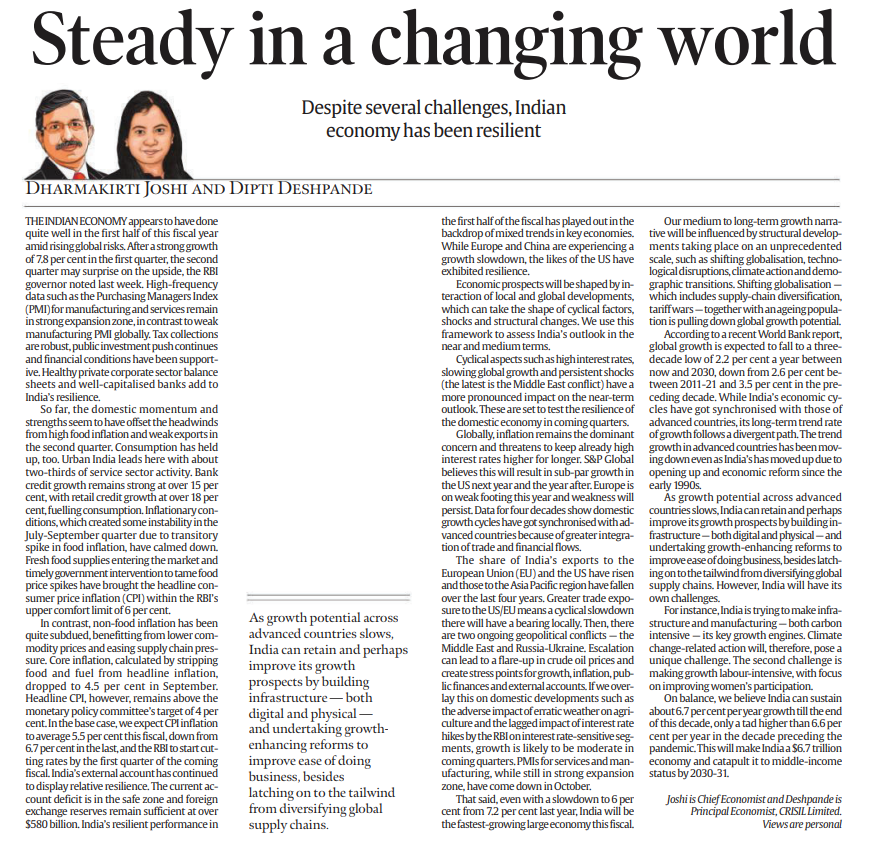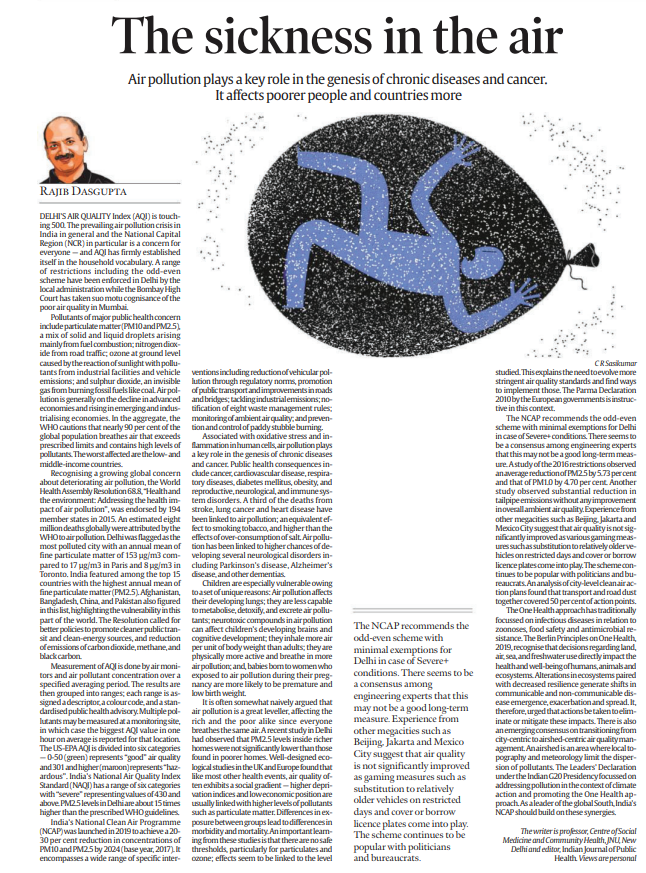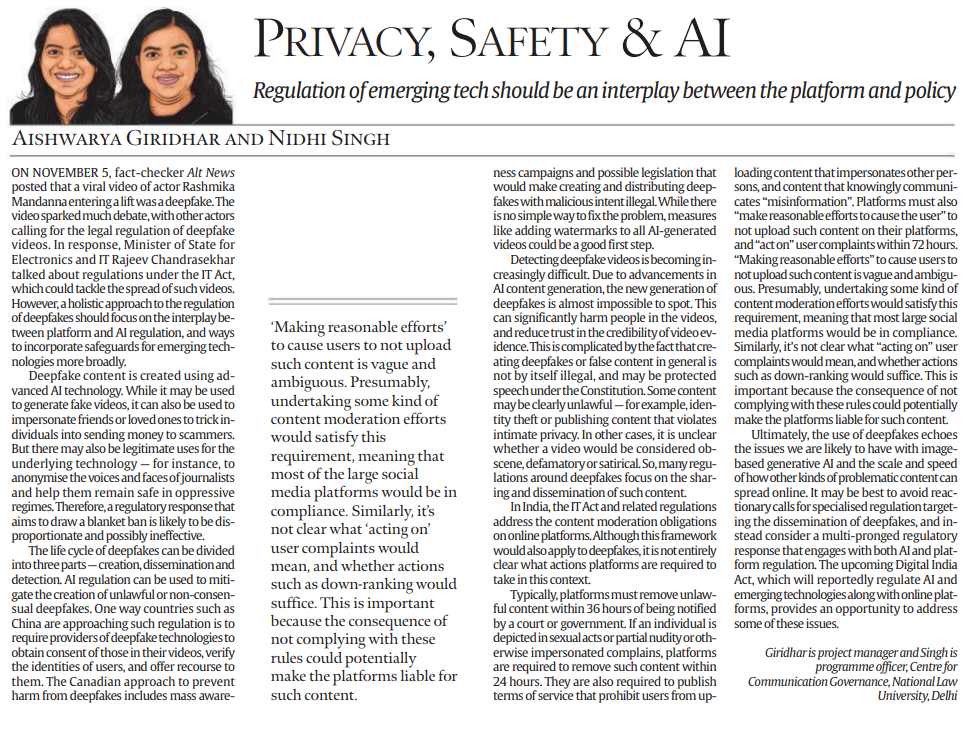India's Economic Performance and Prospects
Introduction
The Indian economy has demonstrated resilience in the first half of the fiscal year, defying global risks. This editorial analysis provides an analysis of the country’s economic performance and prospects with a focus on both near-term and medium-term factors.
Near-Term Outlook
- Strong Domestic Momentum: India’s economy grew at a robust 7.8% in the first quarter, with expectations of a positive second quarter.
- Healthy Indicators: High-frequency data, such as the Purchasing Managers Index (PMI) for manufacturing and services, remains in strong expansion territory, tax collections are robust, and financial conditions are supportive.
- Consumption and Credit Growth: Consumption has held up, with strong bank credit growth, particularly in retail credit, driving consumption.
- Inflation Dynamics: Inflationary conditions have calmed down after a transient food inflation spike, while non-food inflation remains subdued.
- External Resilience: India’s external account remains robust, with a manageable current account deficit and sufficient foreign exchange reserves.
Global Influences on the Near-Term
- Global Risks: Cyclical factors like high interest rates, slowing global growth, and geopolitical shocks (e.g., the Middle East conflict) pose challenges to India’s near-term economic outlook.
- Inflation Concerns: Global inflation remains a dominant concern, potentially leading to extended periods of high-interest rates.
- Trade Exposure: Greater trade exposure to the US and EU can affect India’s economy if these regions experience a slowdown.
Medium to Long-Term Outlook
- Structural Factors: The medium to long-term growth narrative will be shaped by structural changes on a global scale, including shifting globalisation, technological disruptions, climate action, and demographic transitions.
- Shifting Globalisation: Changing global trade dynamics, including supply-chain diversification and tariff wars, will influence India’s growth.
- Climate Action Challenge: India aims to make infrastructure and manufacturing its key growth engines, but these sectors are carbon-intensive, posing a unique challenge in the context of climate action.
- Labor-Intensive Growth: India must work on making growth more labor-intensive, with a focus on improving women’s participation.
India’s Growth Prospects
- Short-Term Growth: Despite potential headwinds, India is expected to sustain around 6.7% growth per year, making it the fastest-growing large economy in the current fiscal year.
- Medium-Term Growth: India’s long-term trend rate of growth is on an upward trajectory, driven by economic reforms and global integration.
- Challenges Ahead: India will need to address challenges related to climate action, labor-intensive growth, and ongoing global economic shifts to maintain and improve its growth prospects.
Conclusion
India’s economy has shown remarkable resilience in the face of global risks in the near term, and its growth prospects in the medium to long term are positive. However, the country must navigate structural changes and challenges to secure its position as a key player in the global economy, ultimately reaching middle-income status by 2030-31.
Air Pollution Crisis in Delhi and India: A Growing Concern
Introduction
Delhi’s Air Quality Index (AQI) touching 500 raises concerns about the persistent air pollution crisis in India, particularly in the National Capital Region (NCR). The AQI has become a household term as restrictions like the odd-even scheme are enforced in Delhi, and even Mumbai’s air quality is being scrutinized by the Bombay High Court.
Key Pollutants and Their Sources
- The major pollutants of public health concern include particulate matter (PM10 and PM2.5), nitrogen dioxide, ozone, and sulfur dioxide.
- PM arises mainly from fuel combustion, nitrogen dioxide from road traffic, ozone from sunlight reactions with industrial and vehicle emissions, and sulfur dioxide from burning fossil fuels.
- Notably, air pollution is increasing in emerging and industrializing economies while decreasing in advanced economies.
- Nearly 90% of the global population breathes air exceeding recommended limits, with low- and middle-income countries being the worst affected.
Global Concern and WHO Resolution
- Recognizing the global concern over deteriorating air quality, the World Health Assembly Resolution 68.8 in 2015 aimed to address the health impact of air pollution.
- The WHO attributed eight million deaths globally to air pollution, with Delhi being identified as the most polluted city.
- India, along with Afghanistan, Bangladesh, China, and Pakistan, ranked among the top 15 countries with the highest PM2.5 levels.
- The resolution called for cleaner public transit, clean energy sources, and reduced emissions of carbon dioxide, methane, and black carbon.
Air Quality Index (AQI) and Standards
- Measurement of AQI is done through air monitors, and the results are categorized into different ranges.
- The US-EPA AQI has six categories, with “good” air quality ranging from 0-50 and “hazardous” at 301 and above. India’s National Air Quality Index Standard (NAQI) includes six categories, with “severe” representing values of 430 and above.
- In Delhi, PM2.5 levels are about 15 times higher than WHO guidelines.
National Clean Air Programme (NCAP)
- India’s National Clean Air Programme, launched in 2019, aims to reduce PM10 and PM2.5 concentrations by 20-30% by 2024.
- It includes interventions to reduce vehicular pollution, promote public transport, address industrial emissions, manage waste, monitor air quality, and control paddy stubble burning.
Health Impacts
- Air pollution plays a crucial role in the development of chronic diseases and cancer.
- It leads to health consequences such as cancer, cardiovascular disease, respiratory diseases, diabetes, obesity, and various neurological and immune system disorders.
- A significant portion of stroke, lung cancer, and heart disease deaths is attributed to air pollution.
Vulnerability of Children
- Children are particularly vulnerable to air pollution due to their developing lungs, limited ability to detoxify pollutants, and exposure to neurotoxic compounds.
- Babies born to mothers exposed to air pollution during pregnancy are more likely to be premature and have low birth weight.
Social Gradient in Air Quality
Contrary to the belief that air pollution affects everyone equally, studies in the UK and Europe indicate that air quality often exhibits a social gradient, with higher deprivation indices linked to higher pollutant levels. These disparities in exposure lead to differences in morbidity and mortality, highlighting the need for more stringent air quality standards.
Long-Term Measures and Odd-Even Scheme
- While the odd-even scheme has been implemented in Delhi as a temporary measure during severe air pollution conditions, experts believe it may not be a viable long-term solution.
- Studies show limited reductions in PM2.5 and PM1.0 levels with this scheme. Similar experiences from other megacities like Beijing, Jakarta, and Mexico City suggest that air quality is not significantly improved.
One Health Approach and Airshed-Centric Management
- The One Health approach has traditionally focused on infectious diseases but now acknowledges that human, animal, and ecosystem health is directly impacted by land, air, sea, and freshwater use.
- Transitioning from city-centric to airshed-centric air quality management is recommended, acknowledging the impact of local topography and meteorology on pollutant dispersion.
- India’s NCAP should leverage these approaches to address pollution comprehensively.
Conclusion
The growing air pollution crisis in Delhi and India necessitates a multi-pronged approach, including stricter air quality standards, comprehensive policies, and a focus on long-term solutions. Acknowledging the health impacts, especially on children, and transitioning to more holistic approaches like the One Health model and airshed-centric management can contribute to better air quality and public health.
Regulation of Deepfake Videos
Introduction
- On November 5, fact-checker Alt News revealed a viral video of actor Rashmika Mandanna entering a lift to be a deepfake.
- The incident sparked significant debate, prompting other actors to call for legal regulation of deepfake videos.
- In response, Minister of State for Electronics and IT Rajeev Chandrasekhar discussed potential regulations under the IT Act to combat the spread of such videos.
- However, a comprehensive approach to deepfake regulation should consider the interplay between platform and AI regulation, and the need for safeguards in emerging technologies.
The Nature of Deepfake Technology
- Deepfake content relies on advanced AI technology to create manipulated videos.
- Its applications vary from creating fake videos to impersonating individuals for fraudulent purposes.
- Yet, legitimate uses also exist, such as anonymizing journalists to protect them in oppressive regimes.
Consequently, imposing a blanket ban on such technology may be disproportionate and ineffective.
The Life Cycle of Deepfakes
- The lifecycle of deepfakes comprises three stages: creation, dissemination, and detection.
- Different countries employ varied regulatory approaches. For instance, China requires deepfake technology providers to obtain consent, verify user identities, and offer recourse to those featured in the videos.
- Canada emphasizes public awareness campaigns and potential legislation to criminalize malicious deepfake creation and distribution.
Introducing watermarks to AI-generated videos is suggested as a starting point for detection.
Challenges in Detecting Deepfakes
- Detecting deepfake videos has become increasingly difficult due to AI advancements, making it almost indistinguishable from genuine content.
- This poses risks to individuals depicted in these videos and erodes trust in video evidence.
- Notably, creating deepfakes is not inherently illegal and may be protected under free speech rights.
- The ambiguity arises when distinguishing between unlawful, obscene, defamatory, or satirical impersonation.
The Role of Online Platforms
- In India, the IT Act and related regulations address content moderation obligations on online platforms.
- However, it is unclear how these apply to deepfakes. The framework typically mandates the removal of unlawful content within specified timeframes, especially for explicit or impersonating content.
- Platforms are also required to publish terms of service prohibiting certain content. However, the terms “making reasonable efforts” and “acting on” user complaints lack clarity, leaving room for interpretation.
Liability Implications
Failure to comply with these rules could potentially hold platforms liable for deepfake content, creating additional legal complexities.
Conclusion,
Regulating deepfakes necessitates a delicate balance between preventing harm and protecting freedom of expression.
A comprehensive approach should encompass creation, dissemination, and detection, addressing both AI technology and platform responsibilities.
Moreover, clear and practical guidelines are essential to ensure effective regulation while safeguarding fundamental rights.






